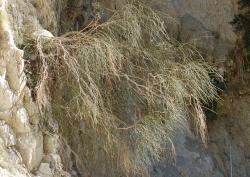- Taxon
- Gallery
Classification
Nomenclature
Scientific Name:
Carmichaelia glabrescens (Petrie) Heenan, New Zealand J. Bot. 36: 56 (1998)
Synonymy:
- ≡ Notospartium glabrescens Petrie, Trans. & Proc. New Zealand Inst. 53: 366 (1921)
Vernacular Name(s):
Pink tree broom
Description
Shrub or small tree up to 10 m. tall, with slender pend. branches (upper branches ascending); branchlets compressed, c. 2.5–3·5 mm. diam. Racemes slender, rather open-fld, up to c. 5 cm. long; peduncle and pedicels glab. Fls purple-flushed and -veined, not crowded, up to 12 mm. long. Calyx glab. to pubescent, teeth narrow-triangular; standard broad. Pods c. 8–25 mm. long, c. 4 mm. broad, subterete, not torulose; beak short, subulate; seeds c. 2 mm. long, reddish yellow mottled with black.
[From: Allan (1961) Flora of New Zealand. Volume 1 as Notospartium glabrescens Petrie]
Biostatus
Indigenous (Endemic)
Bibliography
de Lange, P.J.; Rolfe, J.R.; Barkla J.W.; Courtney, S.P.; Champion, P.D.; Perrie, L.R.; Beadel, S.N.; Ford, K.A.; Breitwieser, I.; Schönberger, I.; Hindmarsh-Walls, R.; Heenan, P.B.; Ladley, K. 2018: Conservation status of New Zealand indigenous vascular plants, 2017. New Zealand Threat Classification Series. No. 22. [Not Threatened]
de Lange, P.J.; Rolfe, J.R.; Champion, P.D.; Courtney, S.P.; Heenan, P.B.; Barkla, J.W.; Cameron, E.K.; Norton, D.A.; Hitchmough, R.A. 2013: Conservation status of New Zealand indigenous vascular plants, 2012. New Zealand Threat Classification Series 3. Department of Conservation, Wellington. [Not Threatened]
Heenan, P.B. 1995: Typification of names in Carmichaelia, Chordospartium, Corallospartium, and Notospartium (Fabaceae - Galegeae) from New Zealand. New Zealand Journal of Botany 33: 439–454. [as Notospartium glabrescens Petrie]
Heenan, P.B. 1998: An emended circumscription of Carmichaelia, with new combinations, a key, and notes on hybrids. New Zealand Journal of Botany 36(1): 53–63.
Petrie, D. 1921: Descriptions of new native flowering-plants, with a few notes. Transactions and Proceedings of the New Zealand Institute 53: 365–371.




